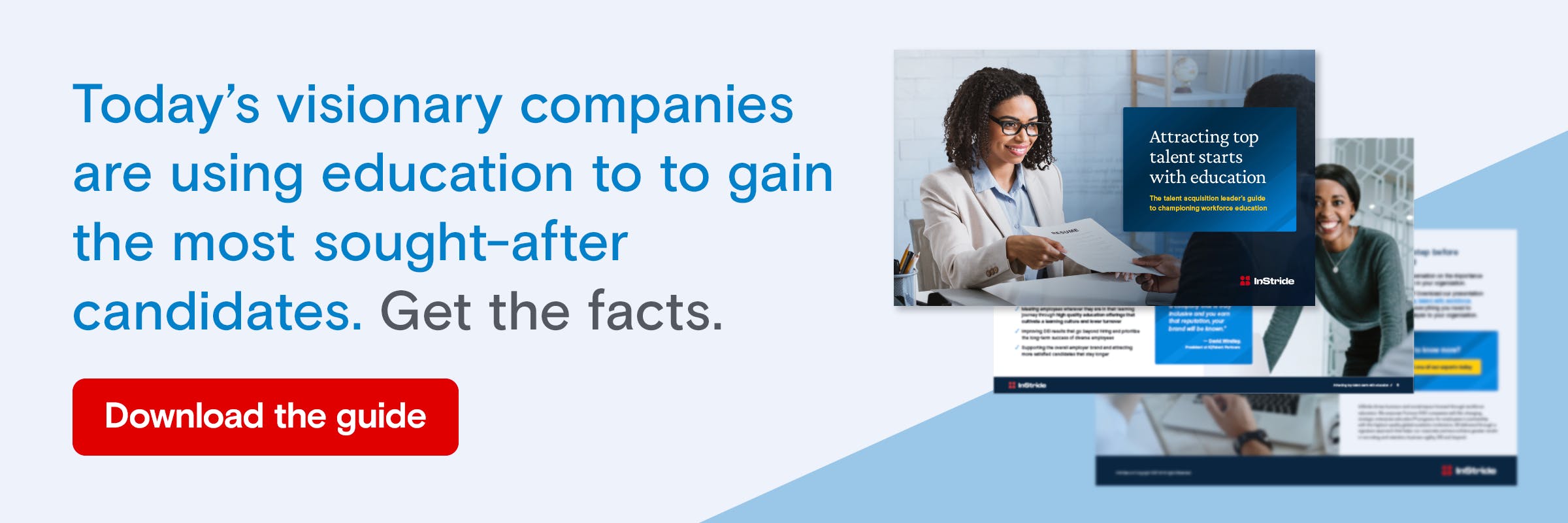Organizations today are scrambling to find skilled employees to fill job openings. Research shows that demand is far exceeding supply, both for internal and external candidates, with 1.9 available jobs per applicant.
Since 2020, human resources (HR) and other people professionals have been overwhelmed by recruiting and retention challenges, drinking from a water hose with no end in sight.
The pandemic and subsequent changes in the job market have forced a reactionary approach to recruiting that’s neither sustainable nor efficient. And while there’s no easy answer, refocusing efforts on filling or strengthening your current talent pool will pay off in the long run, lessening the daily struggle of finding employees externally.
By both expanding and refining the types of candidates in your pool, you’ll have a more valuable resource to pull from and, ideally, a system in place to constantly replenish your talent pool with high-quality candidates.
Let’s take a closer look at how this looks in practice.
What is a talent pool?
A talent pool is a group of potential candidates who have — or might have — an interest in working for your organization. Talent pools may look a bit different depending on the needs of your organization. They can consist of both passive and active job-seekers, as well as internal employees and external employees. This includes current employees who are looking to move up or laterally into new areas or external candidates, including former employees or applicants who have previously applied to jobs at your company.
Talent pools are valuable recruiting tools because they necessitate a proactive approach to filling job openings. You’re starting the process in advance, laying the valuable groundwork for upcoming hiring needs, familiarizing yourself with potential candidates and introducing them more fully to your company before the need ever arises. When the time comes and you need to start hiring, you’ll have a database of potential candidates to turn to before having to kickstart a more formal recruitment process, effectively shortening the time to fill an opening.
Talent pool vs. talent pipeline
The terms talent pool and talent pipeline are often used interchangeably, but there’s an important distinction.
Talent pools include candidates who may have an interest in your company, but not necessarily. Candidates in your talent pool may not even know you exist (yet). But they all have something — perhaps skills, experience, interests or referrals — that make them worthwhile candidates. You’ll draw from these people to fill your talent pipeline.
Candidates in your talent pipeline have been vetted or pre-qualified on some level and you have likely identified how they might contribute to your company. If you want them ready and available when positions open up, you’ll want to nurture internal candidates and purposefully court external candidates, even if there’s no position open for them at the moment. When a position does come up, you’ll turn first to your talent pipeline for a possible candidate, and then pull from your talent pool to replenish your pipeline.
Benefits of talent pool development
In today’s ever-changing job market, the proactive team wins the race.
While you can’t know the exact trajectory of your company’s talent needs and the job market, you can forecast how things might go and then develop your talent pool with various contingencies in mind. This kind of preparation reveals talent concerns before they turn into full-blown crises and additional benefits such as:
- Getting ahead of your company’s talent needs
Your business is always evolving, meaning it’s critically important to stay one step ahead of future talent needs. Prioritizing talent pool development allows you to keep a pulse on what candidates are available and if the candidates in your network have the skills and experience needed for potential future positions. - Creating a reserve of high-quality talent
Without a dedicated talent pool, you have to start the recruitment process over again each time there’s a new opening. This approach allows you to access a database of candidates that already have starting potential to fill a position (and be a good fit) at your company). - Improving your hiring metrics
Talent pools, by definition, allow for a more proactive approach to recruitment, instead of having to react to vacancies and pay for costly advertising, job boards, external recruiters or temporary staffing agencies. While having a talent pool won’t entirely eliminate the need for these additional costs, it does allow for improved efficiency since you already have a database of potential candidates to kickstart the search.
How to grow and cultivate your talent pool
How can you expand your talent pool without draining your resources? Let’s review a few tactics.
Don’t overlook internal talent
A talent pool can and should include existing high-potential employees. You already know internal candidates’ capabilities and, ideally, their career aspirations. Plus, internal candidates are quicker to onboard — they’re already familiar with your company processes and policies.
Current employees may need additional development to acquire the skills needed to grow into an advanced position or make a lateral move to a new team or department. For this reason, it’s important to work hand-in-hand with learning and development (L&D) to ensure your organization has the proper programs in place to upskill and reskill employees. The benefits are two-fold: helping employees achieve their job goals drives engagement and retention, while filling crucial holes in the organization.
Level-up your employer brand
Employee expectations have drastically changed from that of even five years ago, when compensation ruled the negotiating table. To become an employer of choice today, candidates expect enticing benefits that extend beyond a paycheck, with opportunities such as:
- Flexible work schedule/hybrid work
- A workforce education program that provides tuition-free access to degrees, certifications and credentials
- Dedicated budget for professional development activities such as attending industry conferences or workshops
- An inclusive workplace culture that values growth and continuous learning
- Career advancement opportunities
Attracting top talent is not as simple as offerings perks such as company happy hours and ping pong tables. Today’s job-seekers seek out organizations that invest in the growth of their people and offer accessible resources for professional development.
Modernize your talent pool database
Make sure you have a talent management system that’s modern and efficient — one simple enough that your recruitment team knows how to use it, but with robust enough functionality to house all of the valuable data that you need. Outdated software can be a major source of inefficiency and make managing your talent pool laborious and prone to human error.
Think out-of-the-box about upskilling and reskilling
Let’s say you need to fill a position for a technical sales manager, but you don’t have any candidates with technical skills that also have sales and management experience. Is it easier to teach an engineer sales management or upskill a sales manager sufficiently to lead a team of engineers?
This is not a question with a straightforward answer — organizations have to decide this for themselves and curate a talent pool that reflects their business philosophies and talent priorities.
Interestingly, especially for internal candidates, this mismatch of experience is exactly the prescription for building leaders. Some of the best succession plans purposefully move potential leaders into areas or positions where they have less knowledge and experience. Discomforting experiences push people to grow, while introducing them to the gamut of a company or division they may end up running one day. These succession plans see potential in their candidates and recognize their curiosity and drive to learn.
Consider what characteristics you see represented in your key employees and leaders, and aim to fill your talent pool with people who share these qualities.
Re-engage past candidates
There are countless job candidates that don’t end up getting hired for a variety of reasons — whether the position was stalled or an offer simply went to someone else. But people who made it to the interview process could still be a fit for a different role.
Don’t let this potential talent get away. Start the relationship with the rejection letter itself, using it as a tool to entice the candidate to consider you again. And then follow up. Invite them to subscribe to a list of top new positions. Connect on LinkedIn. Let them know of any exciting projects happening in their field. Set up a long-term, low-pressure, relational drip campaign.
Understanding the importance of a diverse talent pool
Even companies working to increase diversity, equity and inclusion in the workplace can demonstrate unconscious bias — at the expense of both job candidates and the companies themselves. Remember that no matter the strides your business may be making, DEI is never “done.”
Failure to address inequitable recruitment practices can have negative business implications that extend far beyond hiring, including limiting innovation and hindering diverse employees from holding leadership positions at your organization. As a counteractive measure, regularly take a close look at your processes and evaluation guidelines for your talent pool.
Prioritize time for talent pool maintenance
Once you’ve incorporated a talent pool into your hiring process, continue to invest in it. You’ve done the hard work of building a database, structure and strategy, but it needs to be filled, edited and replenished regularly to yield results.
Work with your team to regularly review which areas of your talent pool have a healthy number of candidates vs. sections where you may want to increase your efforts. Broaden and narrow as needed. Organizations grow and change and so will their talent needs. You may end up needing candidates with skills you didn’t anticipate or realize something works better. Do not be afraid to adjust your talent pool criteria or the processes surrounding it.
The number one thing is simple: make sure you use it. And if it’s not working, change it — it may need only a tweak to become the most valuable component of your recruitment strategy.
Don’t let candidates forget you either. You can send personalized emails with new job postings as they arise or send out an email newsletter, one targeted to internal candidates and another to external ones. Staying engaged with your talent pool is an important aspect of the development process, especially if someone is on the hunt for a new career. Recruit smarter, not harder
Incorporating talent pool development into your people strategy is key to filling positions efficiently and building the workforce you need. This is a strategic, long-haul approach, one that doesn’t deliver results immediately. You don’t build a talent pool in a day — or even a quarter But with the proper infrastructure and a steady commitment to sourcing and nurturing candidates, this investment can yield dividends across every department in your company.
Skill-building is a critical practice for nurturing and cultivating the candidates in your talent pool. Download this 5-step guide to learn how to accelerate upskilling and reskilling within your organization.


